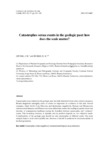Mostrar o rexistro simple do ítem
Catastrophes versus events in the geologic past: how does the scale matter?
| dc.contributor.author | Gutak, J.M. | es_ES |
| dc.contributor.author | Ruban, D.A. | es_ES |
| dc.date.accessioned | 2014-09-23T12:21:11Z | |
| dc.date.available | 2014-09-23T12:21:11Z | |
| dc.date.issued | 2013 | es_ES |
| dc.identifier.citation | Cadernos do laboratorio xeolóxico de Laxe, 2013, 37: 163-180. ISSN: 0213-4497 | es_ES |
| dc.identifier.issn | 0213-4497 | es_ES |
| dc.identifier.uri | http://hdl.handle.net/2183/12583 | |
| dc.description.abstract | [Abstract] Catastrophes were common in the geologic past, but their distinction from other events is necessary. Besides magnitude (strength), scales of events are important in a solution of this task. Several examples, which involve Late Paleozoic and Quaternary megafloods, Hadean and Phanerozoic extraterrestrial impacts, and Phanerozoic mass extinctions, ensure that scaling by spatial extent and diversity of consequences facilitates tracing the boundary between catastrophes and “ordinary” events. This boundary, however, is dynamic and its position depends on our subjective needs. Considerations of the geologic past should not mix catastrophes of different scales. The event analysis helps to avoid such a pitfall, and, therefore, it should be preferred to neocatastrophism in modern geoscience. | es_ES |
| dc.language.iso | eng | es_ES |
| dc.subject | Catastrophe | es_ES |
| dc.subject | Event | es_ES |
| dc.subject | Megaflood | es_ES |
| dc.subject | Extraterrestrial impact | es_ES |
| dc.subject | Mass extinction | es_ES |
| dc.title | Catastrophes versus events in the geologic past: how does the scale matter? | es_ES |
| dc.type | info:eu-repo/semantics/article | es_ES |
| dc.rights.access | info:eu-repo/semantics/openAccess | es_ES |






